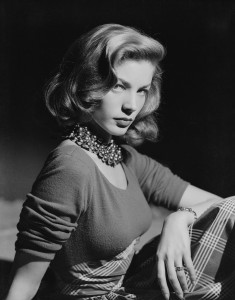Sultry, sexy, her voice famously husky and effortlessly cool, Lauren Bacall epitomized the very definition of “movie starlet” for more than half a century. With her passing on Tuesday at the age of 89, Hollywood has lost one of its greatest actresses.
Bacall’s meteoric rise to fame began in the early 1940s. As early as 17, she was already a darling of high society, gracing the Broadway stage and the covers of magazines like Harper’s Bazaar. But it was her first screen appearance at 20 in Howard Hawks’s 1944 picture “To Have and Have Not” that made her a household name.
In that film’s now-iconic scene, Bacall stands at the door of a dimly lit room, about to leave after having seduced and kissed fishing boat captain Harry “Steve” Morgan (played by her soon-to-be-husband Humphrey Bogart). The scene is ripe with unspoken sexual tension and there is little doubt that Lauren Bacall is the one in complete control.
“You know you don’t have to act with me, Steve,” she begins. “You don’t have to say anything and you don’t have to do anything. Not a thing. Oh, maybe just whistle.”
She starts to exit and then, with an air of unashamed confidence, she casts a glance back at her conquest and delivers one of cinema’s most famous lines: “You know how to whistle, don’t you, Steve? You just put your lips together and blow.”
In a mere instant, the alluring and assured Bacall became a bright and burning entity in the cosmos of movie stardom. Bacall entered cinema almost unannounced, but she immediately commanded the audience’s attention. The “it” factor all great stars have is impossible to define, but whatever “it” is, Lauren Bacall had it.

(Courtesy of The Silver Screen Collection)
The string of films she made with Humphrey Bogart following the success of “To Have and Have Not” – such as the classic 1946 film “The Big Sleep” and the criminally underrated “Dark Passage,” released the following year – made the two actors the screen’s greatest couple. Their chemistry was (and, to this day, still is) unmatched. Bogart’s rugged masculinity, his leer and his unmistakable, sometimes malevolent, grin, caused him to almost always upstage his leading ladies. Bacall, however, somehow managed to never allow that to happen. In some scenes, such as the aforementioned one in “To Have and Have Not,” she even does the unthinkable: She upstages Bogart.
After her husband’s tragic early death in 1957, Bacall continued to star in a variety of movies, television shows and plays until her own death. In many ways, her subsequent parts were unfairly overshadowed by her previous roles as Bogart’s romantic counterpart. Whether appearing in mainstream movies (such as 1974’s “Murder on the Orient Express”) or far less traditional films (such as the two she made with director and screenwriter Lars von Trier, 2003’s “Dogville” and 2005’s “Manderlay”), Bacall proved she was one of the few actresses of a bygone era who could evolve as both times and acting styles changed.
Actors come and go. Most movie stars have their brief moments of fame and then fade away into obscurity. But Lauren Bacall, with the many performances she gave and the variety of movies she was a part of, is truly an unforgettable actress. We need only revisit “Key Largo” or “The Big Sleep” to be reminded once again what true talent really is. Regardless of her role, all eyes were always on her. One thing is for certain: no star has shone brighter.
– Ian Colvin
